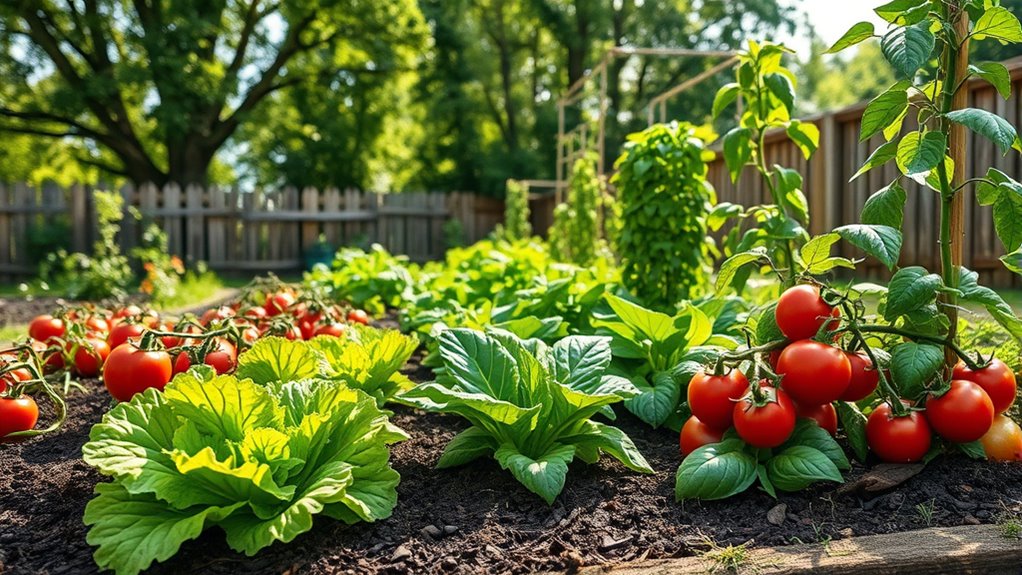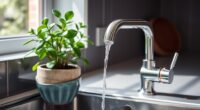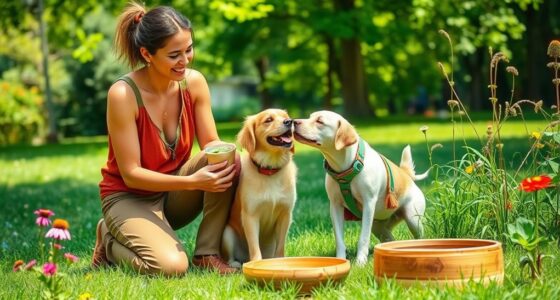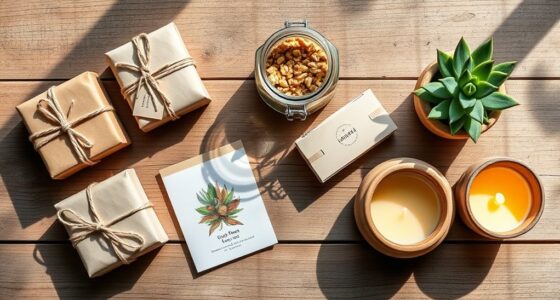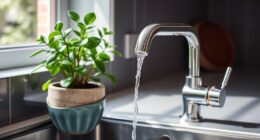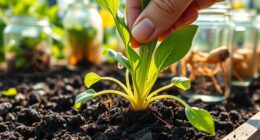Starting a home garden is a great way to grow fresh, healthy food and live more sustainably. Begin by testing your soil’s pH and nutrients, then enrich it with compost or manure to improve fertility and drainage. Choose pest-resistant plants and encourage beneficial insects to naturally keep pests in check. Maintain a clean, well-organized garden, rotate crops, and use natural pest control methods. If you’re keen to create a thriving, eco-friendly garden, there’s more to discover to help you succeed.
Key Takeaways
- Prepare healthy, well-drained soil with organic matter and test pH to ensure optimal conditions for plant growth.
- Select pest-resistant, climate-appropriate vegetables and herbs to reduce pest issues naturally.
- Use organic compost and cover crops to enhance soil fertility and structure over time.
- Practice crop rotation, regular plant inspection, and natural pest control methods like beneficial insects.
- Create a sustainable ecosystem by maintaining garden cleanliness, using physical barriers, and encouraging biodiversity.
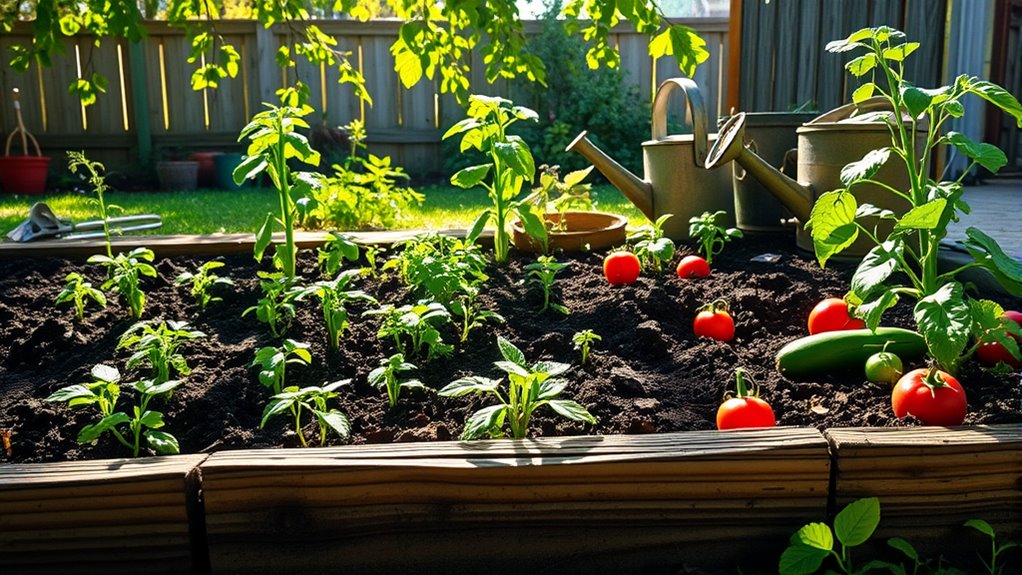
Have you ever thought about transforming your outdoor space into a lush, productive garden? Starting your own home garden is an exciting way to enjoy fresh produce, save money, and connect with nature. To get off to a good start, you need to focus on essential steps like soil preparation and pest management. These foundational elements set the stage for healthy plants and a thriving garden.
First, consider soil preparation. Healthy soil is the key to strong, productive plants. Begin by testing your soil’s pH and nutrient levels using a simple kit or sending a sample to a lab. Once you know what your soil needs, you can amend it accordingly. Most garden soils benefit from the addition of organic matter like compost or aged manure, which improves drainage, aeration, and nutrient content. Loosen the soil by tilling or turning it over to break up compacted layers, making it easier for roots to grow deep. If you’re planting in raised beds or containers, use high-quality potting mix tailored to your crops. Remember, healthy soil promotes vigorous growth and reduces the need for chemical fertilizers, making your garden more sustainable. Additionally, understanding the importance of soil preparation can significantly boost your garden’s success. Incorporating cover crops can also enhance soil fertility over time and prevent erosion.
Healthy soil with organic matter and proper tilling boosts plant growth and garden sustainability.
When it comes to pest management, prevention is your best strategy. Start by choosing pest-resistant plant varieties suited to your climate. Healthy, strong plants are less likely to attract pests, so maintain proper watering, fertilizing, and spacing. Practice crop rotation each season to disrupt pest life cycles and reduce the chance of infestations. Keep an eye out for early signs of pests and act swiftly; removing affected leaves or using natural remedies like neem oil can help control outbreaks without harming beneficial insects. Encourage beneficial insects like ladybugs and lacewings, which prey on pests, by planting companion plants such as marigolds or basil nearby. Physical barriers like row covers can also protect your plants from flying insects. Regularly inspecting your garden and maintaining cleanliness—removing debris and weeds—further minimizes pest habitats. The goal is to create a balanced ecosystem where pests are naturally kept in check, reducing the need for chemical pesticides that can harm your plants and the environment. Implementing integrated pest management practices can lead to a healthier and more productive garden overall.
Frequently Asked Questions
What Are the Best Vegetables for Small Garden Spaces?
When choosing vegetables for small garden spaces, focus on compact plants like lettuce, radishes, and cherry tomatoes. These thrive with proper soil preparation and benefit from companion planting, which helps maximize space and improve growth. You can grow multiple vegetables close together, making the most of your limited area. Regularly amend your soil with organic matter to guarantee healthy plants and a bountiful harvest in your small garden.
How Often Should I Water My Home Garden?
Watering frequency is the secret to thriving plants, and if you don’t get it right, your garden might turn into a desert! For ideal plant hydration, you should water deeply every 2-3 days, adjusting based on weather and soil type. Overwatering can drown roots, while under-watering stresses plants. Keep an eye on soil moisture, and remember, consistent watering keeps your garden lush and productive.
Which Fertilizers Are Safest for Edible Plants?
When choosing fertilizers for your edible plants, you want safe options that won’t harm your health. Organic fertilizers are ideal because they’re natural and chemical-free, providing essential nutrients without synthetic additives. Look for options like compost, fish emulsion, or bone meal. These fertilizers boost plant growth safely and sustainably. Always follow application instructions to avoid over-fertilizing, and you’ll enjoy healthy, tasty produce straight from your garden.
How Do I Prevent Pests Without Chemicals?
To prevent pests naturally, you can use natural pest control methods like introducing beneficial insects such as ladybugs or lacewings that prey on pests. Companion planting also helps; plant marigolds near your vegetables to deter nematodes, or basil with tomatoes to repel flies. Keep your garden healthy by promoting good airflow and removing diseased plants, reducing pest attraction without chemicals. These strategies create a balanced, pest-resistant garden naturally.
When Is the Ideal Planting Season for Beginners?
You might notice spring’s arrival coinciding with your desire to start planting. For beginners, the ideal seasonal planting depends on your climate, but generally, early spring or late summer is perfect. Use beginner tips like choosing easy-to-grow vegetables and planting after the last frost date. This way, you give your garden the best chance to thrive, and you enjoy fresh produce sooner.
Conclusion
By starting your home garden, you’re planting seeds of sustainability and self-sufficiency that will bloom into a lush oasis of abundance. With each sprout and harvest, you nurture not just plants but a greener, more mindful life. Think of your garden as a living canvas, where patience and care paint a masterpiece of nourishment and harmony. Embrace this journey, and watch your world flourish like a garden in full bloom—vibrant, resilient, and full of promise.
